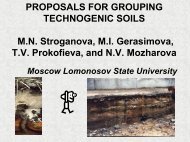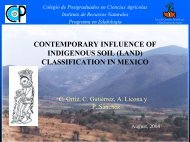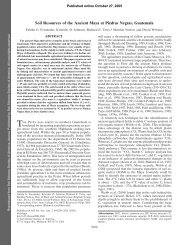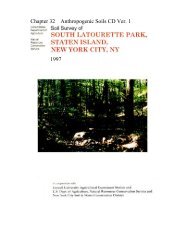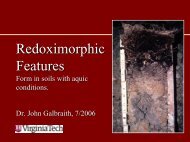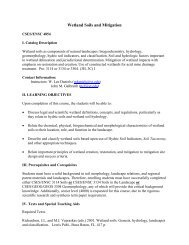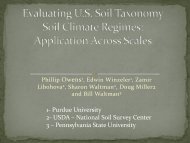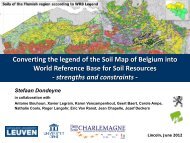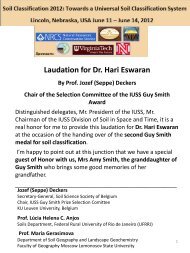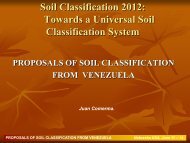Nebraska Soils Field Trip - Virginia Tech
Nebraska Soils Field Trip - Virginia Tech
Nebraska Soils Field Trip - Virginia Tech
Create successful ePaper yourself
Turn your PDF publications into a flip-book with our unique Google optimized e-Paper software.
4th IUSS Soil Classification Conference <strong>Field</strong> Tour Guidebook<br />
contains only the pre-Illinoisan glacial deposits, which overlie an irregular bedrock surface<br />
(Boellstorff 1978a). The most recent glaciation occurred after 780 ka (Brunhes-Matuayma<br />
paleomagnetic boundary) and before 640ka (Lava Creek B tephra deposition, Yellowstone<br />
Caldera) (Boellstorff 1978 a, b). Subsequent, episodic erosion, however, has greatly modified<br />
the original glacial landforms and loess burial has further muted the glacial expression.<br />
Classically, the pre-Illinoisan glacial deposits were known as Kansan and <strong>Nebraska</strong>n<br />
(Chamberlain, 1895). A number of studies (Boellstorff, 1978a, 1978b, 1978c; Hallberg, 1980)<br />
identified multiple glacial deposits with intervening paleosols under stable divides in eastern NE<br />
and Iowa. The stratigraphic complexity, lack of chronological control, and the inability to resolve<br />
regional till correlations compelled abandonment of the terms Kansan and <strong>Nebraska</strong>n (Hallberg<br />
1986).<br />
Loess<br />
Four Pleistocene loess units and one Holecene loess exist in NE. Figure WS2 presents the<br />
general loess stratigraphy with inclusive paleosols and the undifferentiated, underlying pre-<br />
Illinoisan glacial deposits. Youngest to oldest the loesses are Bignell (Holocene), Peoria<br />
(Wisconsin), Gilman Canyon (Wisconsin), Loveland (Illinoisan), and the Kennard formation (pre-<br />
Illinoisan). The Bignell Loess occurs in western NE; it is not a distinct unit in the field area. It<br />
does influence upper soil profile characteristics in eastern NE (Jacobs and Mason 2007). Peoria<br />
Loess is commonly the surficial loess in eastern NE. It is the most widespread and generally the<br />
thickest loess in NE and the Midcontinent.<br />
Figure WS2 <strong>Field</strong> area Quaternary stratigraphy including paleosols.<br />
13



